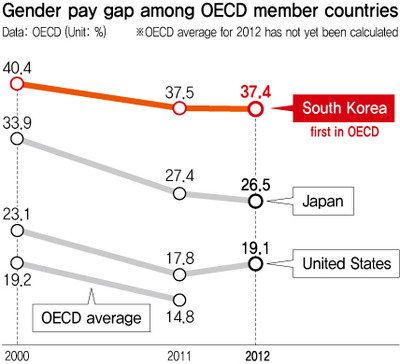Since 2000, S. Korea number one in OECD for gender pay inequality
Gap in South Korea still the biggest, and has shown only slight improvement since data collection began 13 years ago
By Kim So-youn, staff reporter
South Korea has ranked firmly in first place for gender pay inequality among OECD countries for over a decade. Indeed, the size of the pay gap has been drifting further and further from the OECD average as time passes.
OECD data released on Aug. 4 showed South Korea placing first for inequality among eleven member countries in 2012, with a pay disparity of 37.4% between men and women. This means female workers made just 62.6% of what their male counterparts did.
In second place was Japan, with a 26.5% disparity, followed by the US (19.1%), Canada (18.8%), the United Kingdom (17.8%), Slovakia (16%), the Czech Republic (15.1%), Australia (13.8%), Hungary (11.3%), Norway (6.4%), and New Zealand (6.2%). No figures were available yet for the other 23 member countries.
2012 is the thirteenth consecutive year that South Korea has ranked first for gender pay inequality, since the OECD first began collecting data in 2000.
The data also show a very slow rate of improvement: in the 13 years from 2000 to 2013, the gap narrowed by just three percentage points, falling from 40.4% to 37.4%. In contrast, Japan’s gap closed by 7.4 percentage points, going from 33.9% to 26.5%, while the UK’s shrank by 8.5 percentage points over the same period, going from 26.3% to 17.8%.
The OECD average dropped from 19.2% in 2000 to 14.8% in 2011, a 4.4-percentage point decrease. Over the same period, South Korea’s gap dropped just 2.9 percentage points from 40.4% to 37.5%, widening the gap from the rest of the OECD.
The main reason for South Korea’s disparity is the large percentage of women working irregular jobs, which typically have the worst working conditions, amid conditions of severe discrimination by gender and employment type. According to Korea Labour and Society Institute figures, a total of 4,428,000 women were working in irregular jobs as of March, making up 53.8% of the country‘s total of 8,229,000.
Male irregular workers earned an average of 1.74 million won (US$1,690) per month, 53.4% of the 3.27 million won (US$3,170) made by the average male regular worker. For female regular workers, the amount was 2.18 million won (US$2,110), or 66.8%, and for female irregular workers the average was just 1.16 million won (US$1,120), or 35.4%. In other words, the average male regular worker makes roughly three times what the average female irregular worker makes in a month.
Please direct questions or comments to [english@hani.co.kr]




No comments:
Post a Comment